Author:
Notice: Use of undefined constant userphoto - assumed 'userphoto' in /home/netscrib/public_html/civilwarcavalry/wp-content/themes/wittenberg/archive.php on line 41
One Continuous Fight Update
Notice: Use of undefined constant the_post_thumbnail - assumed 'the_post_thumbnail' in /home/netscrib/public_html/civilwarcavalry/wp-content/themes/wittenberg/archive.php on line 65

Sarah Keeney, the marketing director at Savas-Beatie, informed us today that the completed copies of One Continuous Fight: The Retreat from Gettysburg and the Pursuit of Lee’s Army of Northern Virginia, July 4-14, 1863 will ship from the printer tomorrow, right on schedule. Actually seeing a copy of the finished book is only a few days away…..
UPDATE, 10:00 PM: J.D. just called. He spoke to Ted Savas a little while ago–Ted called him on his way into an Iron Maiden concert, of all things. The books shipped today, not tomorrow, and Ted told J.D. that the entire first printing has already been sold. With Plenty of Blame to Go Around: Jeb Stuart’s Controversial Ride to Gettysburg, it took two weeks for the first printing to sell out. This first printing was significantly larger than the one for Plenty of Blame, and it sold out before the books even shipped from the printer.
Geez, we might actually make a few bucks on this one…..
Scridb filterMicrosoft Pulls the Plug on Its Book Scanning Project
Notice: Use of undefined constant the_post_thumbnail - assumed 'the_post_thumbnail' in /home/netscrib/public_html/civilwarcavalry/wp-content/themes/wittenberg/archive.php on line 65

According to this article on CNet News, Microsoft is pulling the plug on its book scanning project, essentially leaving it to Google.
404 for Microsoft’s latest decision
Posted by Charles Cooper
In the middle of a gritty search war, did Steve Ballmer just commit the mother of all mistakes?I’ve been wondering about that ever since Microsoft said it would close its Search Books and Live Search Academic projects, thus ceding the field of book digitization to Google. (While both Live Search Books and Live Search Academic are going dark, both Google’s Book Search and Google Scholar continue to operate.)
Satya Nadella, who runs Microsoft’s Search, Portal and Advertising Platform Group wrote in a blog post that “given the evolution of the Web and our strategy, we believe the next generation of search is about the development of an underlying, sustainable business model for the search engine, consumer, and content partner.”
I tried getting through to Nadella today for a better explanation but Microsoft pulled up the drawbridge. Left on my own to speculate, it appears that Microsoft was being penny-wise but pound foolish. (After all, the company was ready to buy nearly $45 billion worth of trouble integrating Yahoo.) Memo to Nadella: When you get sick of hunkering in the bunker, let’s talk.
Reading through Nadella’s blog post, this much is clear: Microsoft wants to put its search marbles into programs like Cashback, (the new Microsoft service that rebates people to buy products online), where there’s better potential for a material payback. But the search competition with Google is also partly a popularity test. Consider the following:
• Danny Sullivan of SearchEngineLand rightly pointed out to the New York Times that while the number of people using search book services is relatively small, it’s an influential lot with researchers and librarians and other earlier adopters. Don’t underestimate the prestige factor.
• Participation in the project allowed Microsoft to promote itself as being one of the good guys. The Open Content Alliance says it won’t scan books without first receiving permission of copyright owners. Google was sued by authors and publishers over its decision to scan copyrighted snippets without permission. Google argued that the works fell under the category of fair use. Rightly or not, however, Google was pilloried as a bad actor in this novella.
Sullivan sums it up nicely when he writes that “Microsoft got mileage out of the idea it was working with the Open Content Alliance as the “good” book search partner not encumbered by controversy that the Google Book Search service has encountered.
Now Brewster Kahle of the Internet Archive is left scratching his head how to replace Microsoft’s financial support for the consortium. A decade removed from its antitrust battle with the government, Microsoft’s not as uniformly dreaded as it once was. Maybe Microsoft believes it’s in a position where it doesn’t need to buy good will any more. Still, you can never have enough friends.
I’ve also used the Internet Archive site, and find it to have some useful material. I wonder whether this decision by Microsoft will cause it to come crashing down, too.
Scridb filterMemorial Day 2008
Notice: Use of undefined constant the_post_thumbnail - assumed 'the_post_thumbnail' in /home/netscrib/public_html/civilwarcavalry/wp-content/themes/wittenberg/archive.php on line 65

Next week, I will have lived in Columbus for 21 years. There’s a large Victorian cemetery on the west side of town called Greenlawn Cemetery, which describes itself as “a very special park.” Until today, I had never been to Greenlawn. Since it was Memorial Day today, Susan and I decided to pay it a visit in an effort to pay tribute to some of the many military veterans who rest there. It will remind visitors of Hollywood Cemetery in Richmond, Laurel Hill Cemetery in Philadelphia, or Spring Grove Cemetery in Cincinnati–as much Victorian destination as cemetery.
We didn’t get a formal tour, although there were formal tours being offered. That means we missed a lot. Among the interesting graves we missed were Capt. Eddie Rickenbacker’s, a Buffalo Soldier who was awarded the Medal of Honor during the Indian wars, and a soldier who was awarded the Medal of Honor for carrying water to the Reno/Benteen battalion at the Battle of the Little Big Horn. Samuel P. Bush, the grandfather of Pres. George H. W. Bush and the great-grandfather of Pres. George W. Bush, is buried there, as are the grandparents of Pres. Woodrow Wilson. I’m going to have to go back, probably sooner than later, to see the rest of these interesting grave sites.
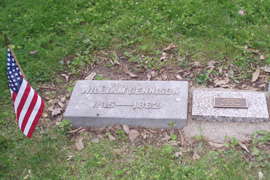
This is the grave of Gov. William N. Dennison, Ohio’s first Civil War-era governor. His son, Lt. William N. Dennison, a talented horse artillerist who served with the Army of the Potomac’s Cavalry Corps, is buried a few feet away.
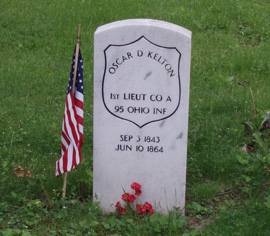
This is the grave of Lt. Oscar Kelton of the 95th Ohio Volunteer Infantry. The Kelton family was prominent in Nineteenth Century Columbus; the family home, which was a stop on the Underground Railroad, is a museum today. Lt. Kelton was KIA during Sherman’s Meridian Campaign in 1864. He was only 21 years old.
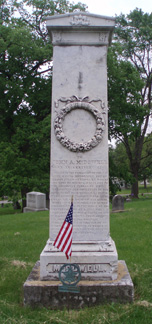
This is the grave of Maj. Gen. Irvin McDowell’s father, who was a War of 1812 veteran.
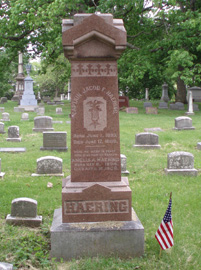
This is the grave of Jacob Haering, a Civil War veteran. I thought it was an extremely interesting monument, which is why I shot it. Note the GAR medal portrayed on the monument.

There are two sections of Civil War veterans. One of them includes a number of unknowns, as well as a number of United States Colored Troops, whose graves are interspersed among the the graves of the white soldiers who served alongside them. This is the grave of Pvt. Andy Grey, who served in the 15th U. S. Colored Infantry.

One of a number of unknown Union soldiers buried in the larger section.
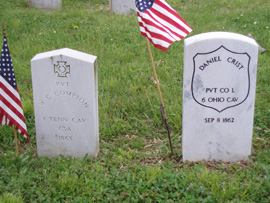
Brothers in arms, if not in service. Private Compton probably died at the Confederate prisoner of war prison site at Camp Chase.
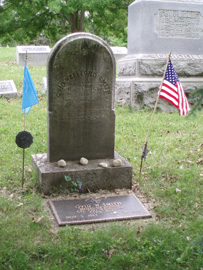
This is the grave of Ovid Wellford Smith, one of the Andrews Raiders, of Great Locomotive Chase fame. Like most of the raiders, Smith was awarded the Medal of Honor for his valor. His grave is the only one in the entire cemetery to have its own state historical marker.
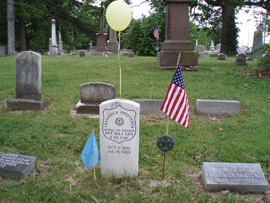
This is the grave of another Medal of Honor winner, Bvt. Maj. Gen. Frederick Phisterer. He was awarded the MOH as a First Lieutenant in the 18th U.S. Infantry for action on December 31, 1862 at Stone River, Tennessee. His citation reads “Voluntarily conveyed, under a heavy fire, information to the comander of a battalion of regular troops by which the battalion was saved from capture or annihilation.”
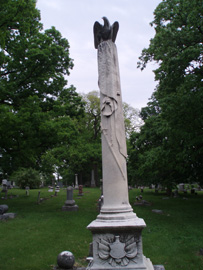
This is the grave marker of a young Union soldier who died of disease at Fortress Monroe in early 1864. The marker depicts a saber, the U.S. flag, an eagle on top, and a detail at the bottom showing a cannon tube, several rifles with bayonets, and several cavalry sabers. It’s without doubt one of the most interesting Civil War grave markers I’ve ever seen. And it belongs to a common soldier, which makes it even more interesting.
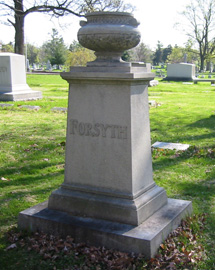
Thanks to Susan Forsyth for passing this one along. This is the grave of Brig. Gen. James William “Tony” Forsyth, Philip H. Sheridan’s chief of staff, who commanded the U. S. troops at the Wounded Knee episode in 1890. Forsyth was married to one of Governor Dennison’s daughters.
To all of our veterans, past, present, and future, thank you for your sacrifices in giving us the country that we enjoy today, and a special thank you to SSgt. Morton L. Wittenberg, 14th Air Force, who served in North Africa and Italy during World War II, and who shuffled off this mortal coil much too soon in December 1980.
Scridb filterAndy German on George D. Bayard
Notice: Use of undefined constant the_post_thumbnail - assumed 'the_post_thumbnail' in /home/netscrib/public_html/civilwarcavalry/wp-content/themes/wittenberg/archive.php on line 65

My old friend Andy German, who is THE authority on all things 1st Pennsylvania Cavalry, left a really outstanding comment to my post on George D. Bayard. So good, in fact, that I decided to feature it here:
Hello Eric,
I’m just catching up with your posts. It’s great to give Bayard his due. From my work on the 1st Pennsylvania Cavalry, he’s an old friend. It’s true that his volunteer troopers initially hated him for his strict discipline–and he knew that some had threatened to shoot him the first time they got to fire on the enemy–but after that first winter of instruction they had complete confidence in him. At a time when the federal cavalry in the east was trying to find its footing, he pushed his command and they met expectations. You mentioned the reconnaissance at Falmouth, which was actually a night attack to secure the bridge, thwarted by an ambush. At the end of May, Bayard’s “Flying Brigade” (which included a battalion of the “Bucktails” (riflemen) and a battery of mountain howitzers) reconnoitered far south of Fredericksburg, then immediately turned around and marched to the Valley, catching the end of Jackson’s column at Strasburg before Fremont’s command finished its much shorter march to complete the pincer movement. Then the cavalry led the federal advance through the rain, fighting aggressively with Jackson’s rear guard. You even see dismounted tactics employed here.
Under Pope, Bayard and Buford acted independently but supportively. Bayard’s fighting withdrawal from the Rapidan slowed Jackson’s advance by a day and permitted Pope to get into position at Cedar Mountain. There, Bayard sacrificed one battalion of his 1st Pennsylvania in a mounted charge against infantry. Later, as the Army of Virginia withdrew across the Rappahannock, Bayard conducted a successful mounted engagement with Confederate cavalry–a mini Brandy Station I. His troops then held Thorofare Gap against Longstreet and during Second Manassas maintained a cavalry presence on the left flank, prepared for a night cavalry charge in the center, and held the rear during the retreat to Centreville.
He remained in command of the cavalry in front of DC during the Antietam Campaign, but conducted scouts as far as Warrenton and proposed a mounted raid not unlike Stoneman’s Raid of six months later. As mentioned, his brigade joined the AoP at the beginning of November, and Pleasonton was not happy to be outranked by such a young officer. Bayard’s brigade performed well at Aldie, at Warrenton, and in the night seizure of the bridge at Rappahannock Station. At Fredericksburg, his brigade in the Left Grand Division was the only cavalry engaged. On the day before the battle they felt out the Confederate position and skirmished sharply with Confederate infantry along the railroad. After Pelham’s artillery flank attack, the 1st Pennsylvania was deployed to picket the left flank and sat on horseback all day under artillery fire. The rest of the brigade remained near Franklin’s headquarters, where Bayard was mortally wounded. It was speculated that a bolt from the Confederate Whitworth gun did the deed as the range was too great for conventional artillery. What a sad fluke.
Bayard’s death was a great loss, and his men found they missed his leadership greatly. They came to appreciate David Gregg’s fatherly leadership, and would do anything for him, but Gregg didn’t have the dash of Bayard. We can’t know for sure, but I’d say Bayard would have made a great division commander. His confidence in the mounted arm and comfort in independent command probably would have made him support the cavalry corps concept. Whether he would have suffered some of the fools in command and been able to manage the whole show is an intriguing question.
Thanks,
Andy German
Thanks for the input, Andy.
Scridb filterGood Luck to Tom Cartwright
Notice: Use of undefined constant the_post_thumbnail - assumed 'the_post_thumbnail' in /home/netscrib/public_html/civilwarcavalry/wp-content/themes/wittenberg/archive.php on line 65

Hat tip to Sam Hood for passing this article along.
The following article ran in today’s issue of the Williamson Herald newspaper:
Cartwright Resigns as Carter House Executive Director
By CAROLE ROBINSON, Staff Writer
crobinson@williamsonherald.comEven with the sounds of traffic passing along Columbia Avenue only 20 yards away, Thomas Cartwright manages to take Carter House visitors back in time to Nov. 30, 1864 and the bloodiest hours of the Battle of Franklin.
For those who have had Cartwright as their tour guide, or have heard him speak publicly, his knowledge, his passion and his love and respect for the warriors on both sides of the picket line, has made the battle and those who fought come alive to be remembered.
The job of telling the stories of Gen. Patrick Cleburne, Gen. John Bell Hood, the Carter family and “the bloodiest hours of the American Civil War,” will now fall to others.” Thomas Cartwright resigned his position as executive director of the historic Civil War house and museum earlier this week after more than 19 years.
“I have been offered some great opportunities doing some consulting,” Cartwright said. “This was not a snap decision. I thought about it. I prayed about it a long time. I love this site with all my heart–that will never change. I love working here–every afternoon at 4 o’clock I think of Capt. Tod Carter on his horse Rosencrantz saying,’I’m going home today.'”
He was mortally wounded just 525 feet from his home.
Opportunities to guide battlefield and historical tours across the country, including a Lewis and Clark tour and even in World War II European battlefield tours are also on the horizon for the 52-year-old historian.
Cartwright said he also looks forward to finishing his book, “The Mascots of the Civil War” and creating some non-historical books, such as a compilation of his collection of old animal photos from 1840 to the 1920s.
An ardent student of history, Cartwright was hired by the Carter House Board of Directors in January 1989 to identify artifacts and interpret the battle, the family, the town and the impact of the war. He became the museum’s military curator in April 1990 and executive director of the Carter House Nov. 7, 1997.
For him the job was so much more–it was a passion.
“Every day of my life I live the Battle of Franklin,” he said. “So many people have influenced my life, including Herbert Harper who saved the Carter House–it was going to be a gas station. I learned from the historians and the guests. If I’ve learned anything, I’ve learned it’s risky–dangerous–to judge the past with our eyes.”
A Nashville native, Cartwright’s interest in the Battle of Franklin began at a very early age when he listened to his grandmother tell stories of her father, who fought in the battle.
“I would love to sit with my grandparents and the old folks–aunts, uncles–and hear their stories over and over again; just stories about people. I think it’s important to know those personal stories– the human side and influence.”
When he was 5, he visited the McGavock cemetery (at Carnton).
“Afterwards, I remember riding by the Carter House and my mother pointed and said, ‘That’s where all the generals were killed.'”
On Nov. 30, 1964–he was 8–he joined his family in Franklin to celebrate the 100th anniversary of the Battle of Franklin and he recalls the impact of the guide putting a finger in the bullet hole in the family room of the Carter House. As Cartwright got older he tagged along with older boys on relic hunts for mini balls and cannon ball fragments in fields around Franklin and the soil of construction sites.
Since his mother worked for a publishing house, his appetite for history was all the more satiated when the owner would send him history books like “The Blue & The Gray.”
“While others were reading their comic books, I read history books,” he said. “I love all types of history. It’s the people–the personal stories that bring it alive. It’s important to honor them–to tell their stories and keep their memories alive–not glorify their deaths, but glorify their lives. Then we won’t repeat the same mistakes. On one aspect, I hate war and hurting other people, but the other aspect is the human side that captures me. I’m reminded of the quote, ‘In times of peace, sons bury their fathers. In times of war, fathers bury their sons.’ That typifies the Carter House. The Battle of Franklin demonstrated the best and the worst of mankind.”
During his 19 1/2 years at the Carter House, Cartwright said he continued learning through the many great historians he had the pleasure to meet and visitors who related their own family stories.
“So many people have been good to me and to the Carter House–I can’t name them all. I just hope a speck of their greatness has fallen on me so I can carry them with me. They are a part of my life and they will always be a part of my life. I’m the richest man of the face of the earth.”
Nancy Conway, who has been on the Carter House Board of Directors for more than 30 years, said Cartwright’s work has brought the site national, even international attention.
“It is not just what he did here, but the presence of Thomas across the United States that have identified Franklin, Tennessee, and the Carter House as significant Civil War sites,” Conway said.
Author Robert Hicks was with Cartwright on Monday and considers him a close friend.
“Thomas’s departure will leave a huge hole that nobody will really be able to fill for a long time in preservation,” Hicks said. “His passion for the Carter House and history is gigantic.”
Carter House Board of Directors President Shanon Wasielewski said the board is grateful for Cartwright’s 19 1/2 years of service.
“Thomas will be greatly missed. We appreciate everything he has given to the site and wish him the very best as he pursues his new opportunities,” Wasielewski said. “He has made an indelible mark on not only The Carter House, but on the interpretation of the Battle of Franklin and on those that have toured the house or had the fortune of hearing him speak during his tenure as executive director. Many people have been drawn to The Carter House because of Thomas Cartwright.” David Fraley, currently The Carter House historian and assistant curator, will serve as the interim executive director while the board is conducting a nationwide search for Cartwright’s replacement.
“We are fortunate to have someone like David who can help the organization through this transition,” Wasielewski said. “David brings a wealth of experience to the position as has hands on knowledge and expertise regarding The Carter House. He has served in key positions with the historic site for more than seven years.”
Posted on: 5/22/2008
Tom Cartwright has done a superb job of overseeing and preserving the Carter House, and he leaves with its land holdings being expanded and more of the Battle of Franklin’s battlefield protected than ever. He’s been a superb steward, and he will be missed in Franklin. Good luck to Tom with his new ventures.
Scridb filterI Don’t Get This….
Notice: Use of undefined constant the_post_thumbnail - assumed 'the_post_thumbnail' in /home/netscrib/public_html/civilwarcavalry/wp-content/themes/wittenberg/archive.php on line 65

Time for a rant. It’s been a while since the last one.
Google Book Search can be an extremely valuable resource. However, its usefulness can be severely limited by a practice that I REALLY don’t understand. More on that in a moment.
I remain as vehemently opposed to the concept of Google scanning works that are still covered by copyright as I have ever been. The flagrant disregard of intellectual property rights offends me deeply, and I will never support that aspect of the Google problem.
At the same time, the database of public domain materials is tremendously useful. I’ve made very extensive use of it, and I appreciate it. However, there is an aspect of the program that I just don’t get. There are a number of scanned works that I’ve encountered that can be looked at, but you can’t print them out, and you also cannot download them to your computer. They’re all in the public domain, so I cannot begin to understand what the rationale might be for such a moronic practice. Obviously, the library that owns the book has placed this idiotic restriction on the use of the material, and it infuriates me to no end. Where the book is in the public domain, there simply is NO justification for such an idiotic policy.
It’s akin to dangling a bottle of whiskey in front of an alcoholic and then expecting that alcoholic to not take a drink from that bottle. There is no justification for teasing a researcher like that. It leaves the work almost useless, and I’ve had just about enough of it.
Sorry for the rant, but I needed to get that off my chest.
Scridb filterA New One on Me
Notice: Use of undefined constant the_post_thumbnail - assumed 'the_post_thumbnail' in /home/netscrib/public_html/civilwarcavalry/wp-content/themes/wittenberg/archive.php on line 65

Today, Susan and I attended an encampment/reenactment of the French and Indian War held about twenty miles from our house. I’d never even heard of reenactments of the French and Indian War previously, so this was a new one on me. We heard about it this morning on the TV news and decided to check it largely because we didn’t have anything planned for the day and it seemed like a good way to kill an hour or two.
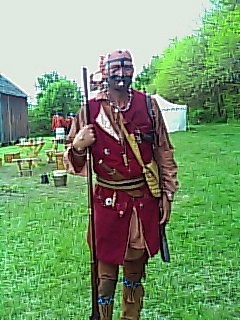 Coincidentally, the event was held at a place called Infirmary Mound Park, named for the pre-historic Indian burial mound located on the property, so I guess it was an appropriate venue for the event. I’m sad to say it wasn’t much of a reenactment. There were nine French soldiers, two Indians, and five or six British soldiers. That doesn’t allow for much in the way of tactical accuracy, so instead, they fired a few volleys, the two Indians looked fierce (see the photo with this post), and the small crowd seemed to eat it up.
Coincidentally, the event was held at a place called Infirmary Mound Park, named for the pre-historic Indian burial mound located on the property, so I guess it was an appropriate venue for the event. I’m sad to say it wasn’t much of a reenactment. There were nine French soldiers, two Indians, and five or six British soldiers. That doesn’t allow for much in the way of tactical accuracy, so instead, they fired a few volleys, the two Indians looked fierce (see the photo with this post), and the small crowd seemed to eat it up.
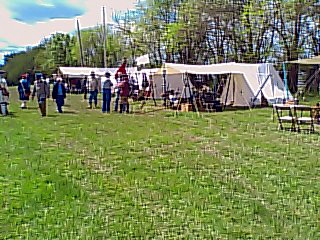 The encampment featured half a dozen or so tents for either side, and not much else, other than some women reenacting period dress and cooking and serving period food over campfires. There was one sutler, selling buck skinning supplies. There were probably forty or so spectators there, in part because they changed the time of the actual reenactment at the last minute due to predictions of bad weather (that never materialized).
The encampment featured half a dozen or so tents for either side, and not much else, other than some women reenacting period dress and cooking and serving period food over campfires. There was one sutler, selling buck skinning supplies. There were probably forty or so spectators there, in part because they changed the time of the actual reenactment at the last minute due to predictions of bad weather (that never materialized).
The reenactors themselves varied in their authenticity. Most of the French soldiers wore glasses, and none of them were period appropriate. Here they are in 1750’s uniforms and modern spectacles. It made them look extremely farby. The two Indians cut pretty intimidating figures; one of them had even pierced the septum of his nose and had run a piece of metal through it. The British soldiers didn’t look too terribly bad, but there were also only six of them, too few to make a difference.
I think it might have been a very interesting event had there been sufficient manpower on both sides. It kind of whet my appetite to see another similar event, only with more men. I likewise think it would be interesting to see a Revolutionary War reenactment, which is something else I have never seen.
Scridb filterWebsite Launch, Part 2
Notice: Use of undefined constant the_post_thumbnail - assumed 'the_post_thumbnail' in /home/netscrib/public_html/civilwarcavalry/wp-content/themes/wittenberg/archive.php on line 65

Here I am, once again engaging in acts of shameless self-promotion…..
I’m pleased to announce the launch of my other new web site, ericwittenberg.com. Please stop by, check it out, and let me know what you think. Thanks for your time, and thanks also for your indulgence of my efforts at self-promotion.
The good news is that there’s only one more of these self-promoting posts left to go….
Scridb filterBrig. Gen. George D. Bayard
Notice: Use of undefined constant the_post_thumbnail - assumed 'the_post_thumbnail' in /home/netscrib/public_html/civilwarcavalry/wp-content/themes/wittenberg/archive.php on line 65

It’s been quite a while since I profiled a forgotten cavalryman, so I think it’s time to do so again. Today’s subject is Brig. Gen. George D. Bayard.
Bayard was born on December 18, 1835 at Seneca Falls, New York. He was a direct, linear descendant of the family of Pierre Terrail, seigneur de Bayard, known as “the Good Knight”. Chevalier Bayard was also called “the knight without fear and without reproach.” George’s great-grandfather had commanded the 1st Pennsylvania Cavalry during the Revolutionary War, so cavalry was in the boy’s blood. When he was 8 years old, the family moved to Iowa for several years. In 1849, the family returned and settled in New Jersey. In 1852, young George was appointed a cadet at large in the Military Academy at West Point by President Millard Fillmore. He graduated in 1856, standing eleventh in a class which originally numbered ninety members. On leaving the Academy, he chose the cavalry arm of the service, and was assigned to duty with the 1st U. S. Cavalry (now the 4th U.S. Cavalry), rising to the rank of captain.
Not long after he joined the regiment, the 1st U.S. Cavalry, was ordered to the plains, where it had frequent encounters with the Indians. In 1860, while engaged with a party of Kiowas, Bayard was severely wounded. His father gave the following account of this event: “After a pursuit of more than twenty miles; some Indians were seen at a distance. Lieutenant Bayard, being mounted on a superior horse, whose speed surpassed that of any in the command, led the way in the chase. He soon came up with an Indian warrior, and, presenting his revolver, demanded his surrender. The Indian, as Lieutenant Bayard rode up to him, had dismounted from his pony for the purpose of dodging the shot from the pistol he anticipated, or to enable him the better to use his bow and arrow. At this moment, while in this attitude, Lieutenant Bayard saw some Indians running at a distance, and turned to see if any of his men were near enough to receive a signal from him that other Indians were in sight, and as he turned again towards the chief he had brought to bay, the latter shot him with his arrow. The arrow was steel-headed, in shape like a spear-head, and the head two and a half inches long. It struck Lieutenant Bayard under the cheek-bone, and penetrated the antrim. If the Indian had not been so near, he would have drawn his bow more taut, and probably killed his enemy.”
The arrow head was imbedded so firmly in the bone that it could not safely be removed except by superior skill. Though enduring intense suffering, Bayard made a journey of 800 miles to St. Louis before he could have the operation performed. Its removal gave some relief, but the wound did not heal, and he was subject to severe hemorrhage which threatened his life. The artery, which had been severed, was cauterized, freeing him from further danger, and he was soon after assigned to duty as cavalry instructor at West Point.
When the war broke out in 1861, even though his wound was still unhealed and very painful, he repeatedly asked to be relieved, and allowed to join a regiment of volunteers. In a letter to his father of April 13, 1861, he wrote: “The capital will very soon be the object of attack, and I think it the duty of all good Americans to march to its defence. My heart is too full to write you anything about Sumter. The Southerners have made a great mistake attacking it. All my sympathy with the South is now gone. It is now war to the knife.” And again, on July 26, 1861 he wrote, “I must go to this war. I cannot stay here and rust while gallant men are in the field. This Rebellion is a much more serious thing than many suppose. I pity the Southern officers in our army. They cannot but condemn the madness of their politicians who have brought on this war, and yet they feel in honor bound to go with their section.”
Finally, his request to be relieved of duty at West Point was granted in September 1861, when he was made major of a newly recruited regiment pf New York cavalry. On his arrival at Washington, Maj. Gen. George B. McClellan, then commander-in-chief, would not consent to his taking this position, and instead gave him the option to take command of a regiment or to serve as an aid upon his staff. Bayard chose an independent command, and was appointed colonel of the 1st Pennsylvania Reserve Cavalry, which was part of the Pennsylvania Reserves, by Keystone State Governor Andrew G. Curtin. He quickly became known as a martinet, and he was not especially popular with the men who served under him. His first speech to his men, delivered as they were about to undertake a hazardous duty, was characteristic: “Men! I will ask you to go in no place but where I lead.”
A friend left this description: “As a soldier, in camp and on the field, in bivouac or in the height of an engagement, he was a perfect model. He had a quiet but keen eye, detecting and correcting what was wrong, and just as quick to discern merit. In the field, he participated in all the hardships with the men, declining a shelter when they were exposed.” During a reconnaissance of Confederate-held bridges outside Falmouth, Virginia, he came under attack, and rifle fire hit his horse three times. He survived the engagement unharmed, and was commissioned Chief of Cavalry of the III Corps and brigadier general of volunteers on April 28, 1862.
When McClellan went to the Peninsula, Bayard remained with the army of observation before Washington. At Cross Keys, and all the subsequent operations under Maj. Gen. John Pope, he acquitted himself with great credit, capably commanding a brigade assigned to Pope’s Army of Virginia. He had been at the Academy with J. E. B. Stuart, and at Cedar Mountain they met; first in conflict, and afterwards under flag of truce for the burial of the dead, where they conversed in a friendly way. No allusion was made to the present war, but they talked of former associations. “During the interview,” says a Washington paper, “a wounded Union soldier lying near was groaning and asked for water. ‘Here, Jeb,’ said Bayard – old time recollections making him familiar as he tossed his bridle to the rebel officer – ‘hold my horse a minute, will you, till I fetch that poor fellow some water.’ Jeb held the bridle. Bayard went to a stream and brought the wounded man some water. As Bayard mounted his horse, Jeb remarked that it was the first time he had ‘played orderly to a Union General.'” Stuart was then a major general in the Confederate service. The business for which they met was soon arranged, and when the bugle sounded the recall, they shook hands and turned away, mortal enemies again.
Despite the disfiguring wound, Bayard was engaged to be married. The wedding was scheduled for his 27th birthday, December 18, 1862. That fall, as the senior cavalry officer, he took the field with the Army of the Potomac. “I have been troubled a good deal of late with rheumatism, owing to having been thoroughly drenched with rain,” he wrote to his father on November 22. “I ought to be in the hospital. But I must go with this army through. I am senior General of cavalry. Honor and glory are before me – shame lurks in the rear. It looks as if I should not be able to leave at the time appointed for my marriage, but will have to postpone it till this campaign is over.”
His cavalry opened the December 13, 1862 Battle of Fredericksburg, holding the enemy in check until the infantry could come up, when he was withdrawn and posted on the extreme left of the line, his left flank abutting upon the river. His command spent the morning of December 13 more or less with the enemy’s skirmishers and advance. His last directions, before leaving his troops to go to the headquarters of Maj. Gen. William B. Franklin, who commanded the Right Grand Division of the Army of the Potomac, were given to his artillery officer to change the position of some of his guns. Bayard then rode off to see Franklin.
“A little before two o’clock he rode to headquarters, to receive such orders as General Franklin might deem proper to give. He found the General in a grove of trees, with some of his staff and other General officers. The enemy were then throwing their shells at and around this grove. General Bayard, soon after he arrived, having dismounted, seated himself at the foot of a tree, but with his face towards the quarter from whence the shells came. He was warned by a brother officer of his needless exposure, and invited to change his position. This he did not do, but remained for some time participating in the conversation of those around. In a little while, however, he rose from his seat, and hardly stood erect, when he was struck by a shell just below the hip, shattering his thigh near the joint. In this frightful condition, with mind still clear and active, he lingered until noon of the following day, arranging his business and sending messages of love and affection to friends.” He dictated a brief note to his parents: “I have to dictate to you a few words, ere it becomes too late. My strength is rapidly wasting away. Goodbye, dearest father and mother; give my love to my sisters.”
He did not appear to suffer much pain, and about 24 hours after being struck, quietly died just five days before his 27th birthday. “Not one,” wrote Horace Greeley, “died more lamented than Major-General George D. Bayard, commanding our cavalry on the left, who was struck by a shell and mortally wounded. But twenty-seven years old, and on the eve of marriage, his death fell like a pall on many loving hearts.” He was buried in Princeton Cemetery in Princeton, New Jersey.
Bayard was the senior officer in the Army of the Potomac’s cavalry at the time of his death. Although Maj. Gen. George Stoneman would have been entitled to command of the Cavalry Corps at the time of its formation in February 1863, Bayard would have been the senior division commander. Thus, when Stoneman took medical leave on May 15, 1863, Bayard would have assumed command of the Cavalry Corps, and not Alfred Pleasonton. The complexion of cavalry operations would have been very different indeed, and it is intriguing to consider what effect Bayard might have had on the evolution of the Army of the Potomac’s Cavalry Corps had he lived.
Scridb filterWeb Site Launch, Part 1
Notice: Use of undefined constant the_post_thumbnail - assumed 'the_post_thumbnail' in /home/netscrib/public_html/civilwarcavalry/wp-content/themes/wittenberg/archive.php on line 65

J. D., Mike, and I are pleased to announce the launch of our new website for the promotion and sale of our new book, One Continuous Fight: The Retreat from Gettysburg and the Pursuit of Lee’s Army of Northern Virginia, July 4-14, 1863. The book is due out in about two weeks. Please check out the website.
Scridb filterNotice: Undefined index: id in /home/netscrib/public_html/civilwarcavalry/wp-content/themes/wittenberg/footer.php on line 8
Notice: Undefined index: id in /home/netscrib/public_html/civilwarcavalry/wp-content/themes/wittenberg/footer.php on line 8
Notice: Undefined index: std in /home/netscrib/public_html/civilwarcavalry/wp-content/themes/wittenberg/footer.php on line 8
Notice: Undefined index: id in /home/netscrib/public_html/civilwarcavalry/wp-content/themes/wittenberg/footer.php on line 8
Notice: Undefined index: id in /home/netscrib/public_html/civilwarcavalry/wp-content/themes/wittenberg/footer.php on line 8
Notice: Undefined index: std in /home/netscrib/public_html/civilwarcavalry/wp-content/themes/wittenberg/footer.php on line 8
Notice: Undefined index: id in /home/netscrib/public_html/civilwarcavalry/wp-content/themes/wittenberg/footer.php on line 8
Notice: Undefined index: id in /home/netscrib/public_html/civilwarcavalry/wp-content/themes/wittenberg/footer.php on line 8
Notice: Undefined index: std in /home/netscrib/public_html/civilwarcavalry/wp-content/themes/wittenberg/footer.php on line 8
Notice: Undefined index: id in /home/netscrib/public_html/civilwarcavalry/wp-content/themes/wittenberg/footer.php on line 8
Notice: Undefined index: id in /home/netscrib/public_html/civilwarcavalry/wp-content/themes/wittenberg/footer.php on line 8
Notice: Undefined index: std in /home/netscrib/public_html/civilwarcavalry/wp-content/themes/wittenberg/footer.php on line 8
Notice: Undefined index: id in /home/netscrib/public_html/civilwarcavalry/wp-content/themes/wittenberg/footer.php on line 8
Notice: Undefined index: id in /home/netscrib/public_html/civilwarcavalry/wp-content/themes/wittenberg/footer.php on line 8
Notice: Undefined index: std in /home/netscrib/public_html/civilwarcavalry/wp-content/themes/wittenberg/footer.php on line 8
Notice: Undefined index: id in /home/netscrib/public_html/civilwarcavalry/wp-content/themes/wittenberg/footer.php on line 8
Notice: Undefined index: id in /home/netscrib/public_html/civilwarcavalry/wp-content/themes/wittenberg/footer.php on line 8
Notice: Undefined index: std in /home/netscrib/public_html/civilwarcavalry/wp-content/themes/wittenberg/footer.php on line 8
Notice: Undefined index: id in /home/netscrib/public_html/civilwarcavalry/wp-content/themes/wittenberg/footer.php on line 8
Notice: Undefined index: id in /home/netscrib/public_html/civilwarcavalry/wp-content/themes/wittenberg/footer.php on line 8
Notice: Undefined index: std in /home/netscrib/public_html/civilwarcavalry/wp-content/themes/wittenberg/footer.php on line 8
Notice: Undefined index: id in /home/netscrib/public_html/civilwarcavalry/wp-content/themes/wittenberg/footer.php on line 8
Notice: Undefined index: id in /home/netscrib/public_html/civilwarcavalry/wp-content/themes/wittenberg/footer.php on line 8
Notice: Undefined index: std in /home/netscrib/public_html/civilwarcavalry/wp-content/themes/wittenberg/footer.php on line 8
Notice: Undefined index: id in /home/netscrib/public_html/civilwarcavalry/wp-content/themes/wittenberg/footer.php on line 8
Notice: Undefined index: id in /home/netscrib/public_html/civilwarcavalry/wp-content/themes/wittenberg/footer.php on line 8
Notice: Undefined index: std in /home/netscrib/public_html/civilwarcavalry/wp-content/themes/wittenberg/footer.php on line 8
Notice: Undefined index: id in /home/netscrib/public_html/civilwarcavalry/wp-content/themes/wittenberg/footer.php on line 8
Notice: Undefined index: id in /home/netscrib/public_html/civilwarcavalry/wp-content/themes/wittenberg/footer.php on line 8
Notice: Undefined index: std in /home/netscrib/public_html/civilwarcavalry/wp-content/themes/wittenberg/footer.php on line 8
Notice: Undefined index: id in /home/netscrib/public_html/civilwarcavalry/wp-content/themes/wittenberg/footer.php on line 8
Notice: Undefined index: id in /home/netscrib/public_html/civilwarcavalry/wp-content/themes/wittenberg/footer.php on line 8
Notice: Undefined index: std in /home/netscrib/public_html/civilwarcavalry/wp-content/themes/wittenberg/footer.php on line 8
Notice: Undefined index: id in /home/netscrib/public_html/civilwarcavalry/wp-content/themes/wittenberg/footer.php on line 8
Notice: Undefined index: id in /home/netscrib/public_html/civilwarcavalry/wp-content/themes/wittenberg/footer.php on line 8
Notice: Undefined index: std in /home/netscrib/public_html/civilwarcavalry/wp-content/themes/wittenberg/footer.php on line 8
Notice: Undefined index: id in /home/netscrib/public_html/civilwarcavalry/wp-content/themes/wittenberg/footer.php on line 8
Notice: Undefined index: id in /home/netscrib/public_html/civilwarcavalry/wp-content/themes/wittenberg/footer.php on line 8
Notice: Undefined index: std in /home/netscrib/public_html/civilwarcavalry/wp-content/themes/wittenberg/footer.php on line 8
Notice: Undefined index: id in /home/netscrib/public_html/civilwarcavalry/wp-content/themes/wittenberg/footer.php on line 8
Notice: Undefined index: id in /home/netscrib/public_html/civilwarcavalry/wp-content/themes/wittenberg/footer.php on line 8
Notice: Undefined index: std in /home/netscrib/public_html/civilwarcavalry/wp-content/themes/wittenberg/footer.php on line 8
Notice: Undefined index: id in /home/netscrib/public_html/civilwarcavalry/wp-content/themes/wittenberg/footer.php on line 8
Notice: Undefined index: id in /home/netscrib/public_html/civilwarcavalry/wp-content/themes/wittenberg/footer.php on line 8
Notice: Undefined index: std in /home/netscrib/public_html/civilwarcavalry/wp-content/themes/wittenberg/footer.php on line 8
Notice: Undefined index: id in /home/netscrib/public_html/civilwarcavalry/wp-content/themes/wittenberg/footer.php on line 8
Notice: Undefined index: id in /home/netscrib/public_html/civilwarcavalry/wp-content/themes/wittenberg/footer.php on line 8
Notice: Undefined index: std in /home/netscrib/public_html/civilwarcavalry/wp-content/themes/wittenberg/footer.php on line 8
Notice: Undefined index: id in /home/netscrib/public_html/civilwarcavalry/wp-content/themes/wittenberg/footer.php on line 8
Notice: Undefined index: id in /home/netscrib/public_html/civilwarcavalry/wp-content/themes/wittenberg/footer.php on line 8
Notice: Undefined index: std in /home/netscrib/public_html/civilwarcavalry/wp-content/themes/wittenberg/footer.php on line 8
Notice: Undefined index: id in /home/netscrib/public_html/civilwarcavalry/wp-content/themes/wittenberg/footer.php on line 8
Notice: Undefined index: id in /home/netscrib/public_html/civilwarcavalry/wp-content/themes/wittenberg/footer.php on line 8
Notice: Undefined index: std in /home/netscrib/public_html/civilwarcavalry/wp-content/themes/wittenberg/footer.php on line 8
Notice: Undefined index: id in /home/netscrib/public_html/civilwarcavalry/wp-content/themes/wittenberg/footer.php on line 8
Notice: Undefined index: id in /home/netscrib/public_html/civilwarcavalry/wp-content/themes/wittenberg/footer.php on line 8
Notice: Undefined index: std in /home/netscrib/public_html/civilwarcavalry/wp-content/themes/wittenberg/footer.php on line 8
Notice: Undefined index: id in /home/netscrib/public_html/civilwarcavalry/wp-content/themes/wittenberg/footer.php on line 8
Notice: Undefined index: id in /home/netscrib/public_html/civilwarcavalry/wp-content/themes/wittenberg/footer.php on line 8
Notice: Undefined index: std in /home/netscrib/public_html/civilwarcavalry/wp-content/themes/wittenberg/footer.php on line 8
Notice: Undefined index: id in /home/netscrib/public_html/civilwarcavalry/wp-content/themes/wittenberg/footer.php on line 8
Notice: Undefined index: id in /home/netscrib/public_html/civilwarcavalry/wp-content/themes/wittenberg/footer.php on line 8
Notice: Undefined index: std in /home/netscrib/public_html/civilwarcavalry/wp-content/themes/wittenberg/footer.php on line 8








 Back to top
Back to top Blogs I like
Blogs I like 